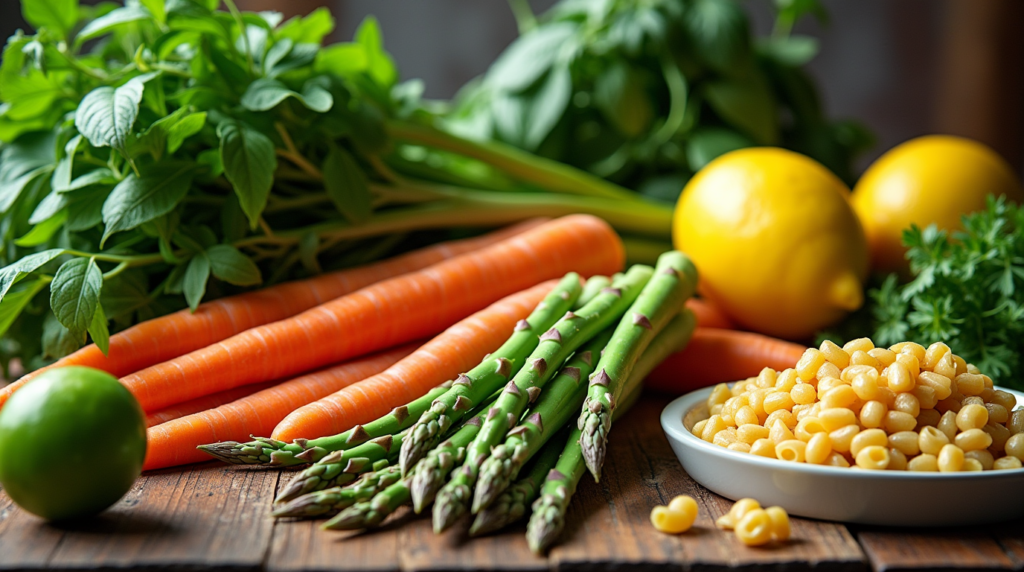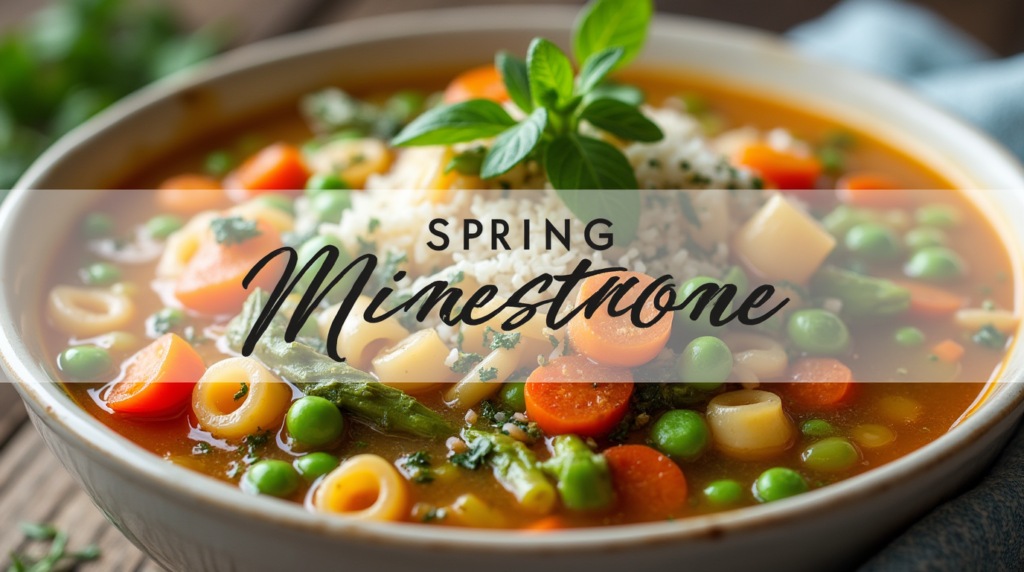Spring Minestrone: A Fresh Take on Classic Comfort
Did you know that one bowl of soup can capture the entire essence of spring while giving you a full day’s worth of vegetables?
When most people think of minestrone, they picture heavy winter soups packed with hearty beans and thick broths. But what if I told you there’s a lighter, brighter version that celebrates everything wonderful about spring? Spring Minestrone is your answer to craving comfort food without the heaviness, bringing together the season’s freshest vegetables in a bowl that’s both satisfying and refreshing.
This isn’t your grandmother’s minestrone (though she’d probably love it too). It’s a vibrant, colorful soup that makes you feel good about eating healthy while actually tasting amazing. Ready to discover why this might become your new favorite spring recipe?

Table of Contents
Overview: What Makes Spring Minestrone Special
Spring Minestrone stands out because it celebrates the season’s best produce while keeping things light and fresh. Unlike traditional minestrone that can take hours to develop deep flavors, this version comes together in just 30 minutes and requires only beginner-level cooking skills.
What makes it truly special:
- Uses fresh, seasonal vegetables at their peak flavor
- Light broth base that won’t weigh you down
- Flexible recipe that works with whatever vegetables you have
- Perfect for meal prep and gets better the next day
- Naturally packed with nutrients and fiber
The beauty of Spring Minestrone lies in its simplicity. You’re essentially creating a celebration of spring in a bowl, where each vegetable gets to shine while contributing to a harmonious whole.
Essential Ingredients: Building Your Spring Symphony
The magic of Spring Minestrone comes from using the right combination of fresh, seasonal ingredients. Here’s what you’ll need:
Base Ingredients:
- 2 tablespoons olive oil – For sautéing and adding richness
- 1 medium onion, diced – Creates the flavor foundation
- 2 carrots, diced – Adds natural sweetness and color
- 2 celery stalks, diced – Provides crunch and classic minestrone flavor
- 3 garlic cloves, minced – Essential for depth
Spring Vegetables:
- 1 medium zucchini, diced – Tender and mild
- 1 cup fresh green beans, trimmed and cut – Classic spring vegetable
- 1 cup fresh or frozen peas – Sweet pop of color
- 2 cups fresh spinach – Wilts beautifully and adds nutrients
- 1 cup asparagus, cut into 1-inch pieces – Quintessential spring flavor
Liquid and Seasonings:
- 6 cups vegetable or chicken broth – Choose high-quality for best flavor
- 1 can (14 oz) diced tomatoes – Adds acidity and body
- 1 teaspoon dried oregano – Classic Italian herb
- 1 teaspoon dried basil – Aromatic and fresh
- Salt and pepper to taste – Essential for bringing flavors together
Finishing Touches:
- 1 cup small pasta (ditalini or elbow) – Optional but traditional
- Fresh parmesan cheese – For serving
- Fresh basil leaves – Bright, aromatic garnish
Smart Substitutions:
- No asparagus? Try snap peas or sugar snap peas
- Out of zucchini? Yellow squash works perfectly
- Don’t have fresh spinach? Kale or Swiss chard are great alternatives
- Want it heartier? Add a can of cannellini beans
- Prefer different pasta? Any small shape works well

Step-by-Step Instructions: Creating Your Spring Masterpiece
Step 1: Prepare Your Vegetables (10 minutes) Start by washing and chopping all your vegetables. This is called “mise en place” in cooking, and it makes everything go smoothly. Dice your onion, carrots, and celery into small, uniform pieces. Cut your zucchini, green beans, and asparagus into bite-sized pieces. Having everything ready makes the actual cooking much easier.
Step 2: Build Your Flavor Base (5 minutes) Heat olive oil in a large pot over medium heat. Add the diced onion, carrots, and celery. Cook for about 4-5 minutes until the onion becomes translucent and the vegetables start to soften. This combination is called a “soffritto” in Italian cooking and creates the flavor foundation for your soup.
Add the minced garlic and cook for another 30 seconds until fragrant. Be careful not to let it burn, as burnt garlic tastes bitter.
Step 3: Add the Heartier Vegetables (3 minutes) Add the green beans and asparagus to the pot. These vegetables need a bit more cooking time than the others, so they go in first. Stir them around for about 2-3 minutes to get them started.
Step 4: Pour in the Liquids (2 minutes) Add your broth and the can of diced tomatoes (including the juice). Bring the mixture to a boil, then reduce heat to medium-low and let it simmer. Add your oregano and basil now so they have time to flavor the broth.
Step 5: Cook the Pasta (if using) (8-10 minutes) If you’re adding pasta, add it now and cook according to package directions. The pasta will absorb some of the broth and add substance to your soup. Stir occasionally to prevent sticking.
Step 6: Add the Quick-Cooking Vegetables (3-5 minutes) Add the diced zucchini and peas. These cook quickly, so they only need a few minutes. You want them tender but still with a bit of bite.
Step 7: Finish with Greens (1-2 minutes) Add the fresh spinach last. It wilts almost immediately, so just stir it in and let it cook for a minute or two until wilted. Taste and season with salt and pepper as needed.
Pro Tips for Perfect Results:
- Don’t overcook the vegetables – they should be tender but still have some texture
- Taste as you go and adjust seasonings
- If the soup seems too thick, add more broth
- If it’s too thin, let it simmer uncovered for a few extra minutes
Assembly: Bringing It All Together
The final assembly is where your Spring Minestrone transforms from good to amazing. Here’s how to serve it like a pro:
Serving Basics: Ladle the hot soup into bowls, making sure each serving gets a good mix of all the vegetables. The beautiful thing about this soup is how colorful it is – you should see green from the peas and spinach, orange from the carrots, and red from the tomatoes.
Presentation Tips:
- Sprinkle freshly grated Parmesan cheese on top
- Add a few torn fresh basil leaves for color and aroma
- Drizzle a tiny bit of good olive oil for richness
- Serve with crusty bread for dipping
Make It Instagram-Worthy:
- Use a white bowl to show off the colors
- Add a small sprig of fresh herbs on top
- Place the bowl on a colorful napkin or placemat
- Take the photo from slightly above to show all the vegetables
The key is to serve it immediately while it’s hot and the vegetables still have their bright colors and fresh textures.
Storage and Make-Ahead Tips
Spring Minestrone is actually one of those soups that tastes even better the next day as all the flavors blend together.
Refrigerator Storage:
- Store in the refrigerator for up to 4 days
- Keep in airtight containers
- The soup may thicken as it sits – just add a bit of broth when reheating
Freezer Storage:
- Freezes well for up to 3 months
- If you used pasta, it might get a bit mushy when thawed
- Consider freezing the soup without pasta and adding fresh pasta when serving
Reheating Tips:
- Reheat gently on the stove over medium-low heat
- Add a splash of broth if it’s too thick
- Taste and re-season as needed
- Don’t boil vigorously as this can make vegetables mushy
Make-Ahead Strategy:
- Prepare all vegetables the night before
- Make the entire soup and store overnight for even better flavor
- Cook pasta separately and add when serving to prevent mushiness
Recipe Variations: Make It Your Own
The beauty of Spring Minestrone is how adaptable it is. Here are some delicious variations to try:
Protein Additions:
- Add cooked white beans for extra protein and fiber
- Stir in cooked chicken for a heartier version
- Try Italian sausage (remove from casing and cook first)
- Add cooked shrimp in the last few minutes
Seasonal Swaps:
- Summer version: Add corn, bell peppers, and fresh tomatoes
- Fall twist: Include butternut squash and cannellini beans
- Winter comfort: Add potatoes and white beans
International Flavors:
- Mexican style: Add cumin, chili powder, and corn
- Asian twist: Use ginger, soy sauce, and bok choy
- Mediterranean: Add olives, feta cheese, and fresh herbs
Dietary Modifications:
- Vegan: Use vegetable broth and skip the cheese
- Gluten-free: Skip the pasta or use gluten-free alternatives
- Low-carb: Skip pasta and add extra vegetables
- Keto-friendly: Add more olive oil and cheese, skip pasta

Conclusion
Spring Minestrone proves that healthy eating doesn’t have to be boring or complicated. This vibrant, fresh soup captures everything wonderful about spring while delivering serious comfort and satisfaction. The best part? It’s so flexible that you can make it with whatever spring vegetables you have on hand or find at your local farmer’s market.
Whether you’re looking for a light lunch, a starter for dinner, or a meal prep solution for busy weeks, Spring Minestrone delivers on all fronts. It’s nutritious, delicious, and guaranteed to make you feel good about what you’re eating.
So grab your favorite pot, head to the produce section, and start experimenting. Your taste buds (and your body) will thank you for this fresh take on a classic comfort food. Remember, the best recipes are the ones you make your own, so don’t be afraid to add your favorite vegetables or adjust the seasonings to your liking.
Happy cooking, and welcome to your new favorite spring recipe!
Frequently Asked Questions
Q: Can I make Spring Minestrone without pasta? A: Absolutely! The pasta is optional. Without it, you’ll have a lighter, more vegetable-focused soup that’s also lower in carbs. The soup is just as delicious and satisfying without pasta.
Q: What vegetables can I substitute if I can’t find the ones listed? A: Spring Minestrone is very flexible. Try bell peppers instead of zucchini, snow peas instead of regular peas, or broccoli instead of asparagus. The key is using fresh, seasonal vegetables you enjoy.
Q: How can I make this soup more filling? A: Add a can of white beans (cannellini or navy beans work great), include some cooked chicken or Italian sausage, or serve with crusty bread and cheese. You can also add more pasta if you’re using it.
Q: Is Spring Minestrone healthy? A: Yes! It’s packed with vegetables, which means lots of vitamins, minerals, and fiber. It’s naturally low in calories and fat (unless you add lots of cheese and oil). Plus, the variety of vegetables provides different nutrients your body needs.
Q: Can I use frozen vegetables instead of fresh? A: You can, but fresh vegetables will give you better texture and flavor. If using frozen, add them directly to the soup without thawing first, and reduce cooking time since they’re already partially cooked.
Q: How long does the soup last in the refrigerator? A: Spring Minestrone will keep in the refrigerator for 3-4 days in airtight containers. The flavors actually improve overnight, making it perfect for meal prep.
Q: Why does my soup look different colors after storing? A: This is normal! Green vegetables like spinach and basil can lose their bright color over time. The soup is still perfectly safe and delicious – it just won’t look as vibrant as when freshly made.
Q: Can I double the recipe? A: Definitely! This recipe doubles well. Just make sure you have a large enough pot. You might need to increase cooking time slightly to ensure all vegetables are properly cooked through.










